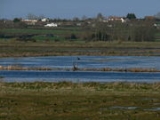
West Sedgemoor
Encyclopedia
West Sedgemoor is a 1016.0 hectare
(2510.0 acre) biological Site of Special Scientific Interest forms part of the Somerset Levels
and Moors in Somerset
, notified in 1983.
The site, part of which is a Royal Society for the Protection of Birds
reserve, comprises numerous small, low lying fields and meadows separated by narrow water-filled rhyne
s and ditches. A rich invertebrate
fauna
is present including scarce water beetles, dragonflies and bugs. The site also supports good populations of waterfowl, especially waders.
Breeding birds include Snipe
, Lapwing
, Redshank
, Curlew
, Water Rail
, Yellow Wagtail and Whinchat
.
Swell Wood, an ancient deciduous wood on the southern edge of the reserve, has one of the UK's largest heronries
, which is best visited between March and June.
Hectare
The hectare is a metric unit of area defined as 10,000 square metres , and primarily used in the measurement of land. In 1795, when the metric system was introduced, the are was defined as being 100 square metres and the hectare was thus 100 ares or 1/100 km2...
(2510.0 acre) biological Site of Special Scientific Interest forms part of the Somerset Levels
Somerset Levels
The Somerset Levels, or the Somerset Levels and Moors as they are less commonly but more correctly known, is a sparsely populated coastal plain and wetland area of central Somerset, South West England, between the Quantock and Mendip Hills...
and Moors in Somerset
Somerset
The ceremonial and non-metropolitan county of Somerset in South West England borders Bristol and Gloucestershire to the north, Wiltshire to the east, Dorset to the south-east, and Devon to the south-west. It is partly bounded to the north and west by the Bristol Channel and the estuary of the...
, notified in 1983.
The site, part of which is a Royal Society for the Protection of Birds
Royal Society for the Protection of Birds
Bird Notes and News was first published in April 1903.The title changed to 'Bird Notes' in 1947. In the 1950s, there were four copies per year . Each volume covered two years, spread over three calendar years...
reserve, comprises numerous small, low lying fields and meadows separated by narrow water-filled rhyne
Rhyne
A rhyne , rhine/rhyne , or reen is a drainage ditch, or canal, used to turn areas of wetland at around sea level into useful pasture....
s and ditches. A rich invertebrate
Invertebrate
An invertebrate is an animal without a backbone. The group includes 97% of all animal species – all animals except those in the chordate subphylum Vertebrata .Invertebrates form a paraphyletic group...
fauna
Fauna
Fauna or faunæ is all of the animal life of any particular region or time. The corresponding term for plants is flora.Zoologists and paleontologists use fauna to refer to a typical collection of animals found in a specific time or place, e.g. the "Sonoran Desert fauna" or the "Burgess shale fauna"...
is present including scarce water beetles, dragonflies and bugs. The site also supports good populations of waterfowl, especially waders.
Breeding birds include Snipe
Common Snipe
The Common Snipe is a small, stocky wader native to the Old World. The breeding habitat is marshes, bogs, tundra and wet meadows throughout northern Europe and northern Asia...
, Lapwing
Northern Lapwing
The Northern Lapwing , also known as the Peewit, Green Plover or just Lapwing, is a bird in the plover family. It is common through temperate Eurasia....
, Redshank
Common Redshank
The Common Redshank or simply Redshank is an Eurasian wader in the large family Scolopacidae.- Description and systematics :...
, Curlew
Eurasian Curlew
The Eurasian Curlew, Numenius arquata, is a wader in the large family Scolopacidae. It is one of the most widespread of the curlews, breeding across temperate Europe and Asia...
, Water Rail
Water Rail
The Water Rail is a bird of the rail family which breeds in well-vegetated wetlands across Europe, Asia and North Africa. Northern and eastern populations are migratory, but this species is a permanent resident in the warmer parts of its breeding range...
, Yellow Wagtail and Whinchat
Whinchat
The Whinchat Saxicola rubetra is a small migratory passerine bird breeding in Europe and western Asia and wintering in Africa.Its scientific name means "small rock-dweller", in reference to its habitat...
.
Swell Wood, an ancient deciduous wood on the southern edge of the reserve, has one of the UK's largest heronries
Heronry
A heronry is a breeding ground for herons, sometimes called a heron rookery.- Asia :* Kaggaladu Heronry is in Karnataka state of India...
, which is best visited between March and June.

